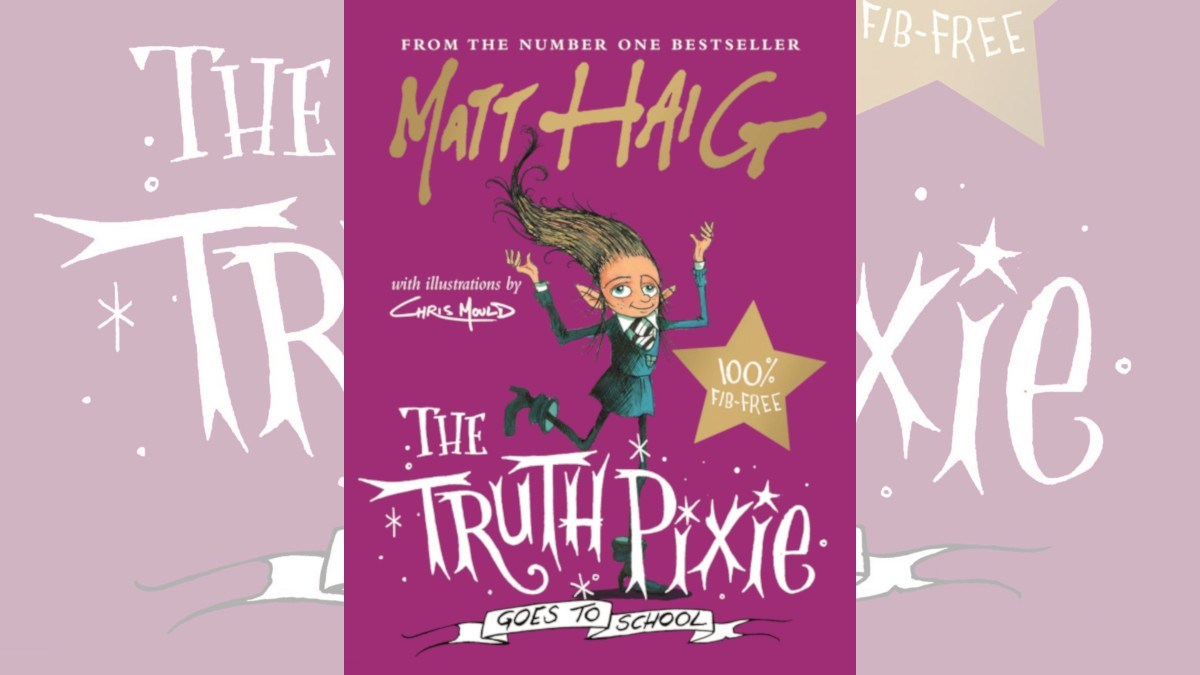Wonderland has lost its wonder, and each character has their own vision to restore the land.
In “Reaping the Rewards,” I take a look at the finished product from a crowdfunding project. Wonderland’s War was originally funded on Kickstarter in March 2020, and shipped to backers in March 2022. While the retail edition is available in stores now, Wonderland’s War has returned to Kickstarter with another opportunity to get the deluxe edition, as well as a new mini-expansion, Shards of Madness.
What Is Wonderland’s War?
Wonderland’s War is a bag-building, area control game for 2 to 5 players, ages 13 and up, and takes about 25 minutes per player. The regular edition retails for $65 and is available in stores and directly from Skybound Games. There is also a Kickstarter campaign running now that includes the deluxe edition, the premium chips, and a new expansion. I’ll break those down in more detail in the components section below. The game can be a bit lengthier (particularly at the full player count), so I would recommend it for younger players only if they have the patience and experience for longer games; the setting is based on Alice in Wonderland with a somewhat more threatening tone, but it doesn’t veer into horror (the way something like American McGee’s version does).
Wonderland’s War was designed by Ben Eisner, Tim Eisner, and Ian Moss and published by Druid City Games, with illustrations by Manny Trembley. (Note that the original campaign was run by Druid City Games in partnership with Skybound Games, but Druid City Games is now independent from Skybound and is managing the new campaign.)
New to Kickstarter? Check out our crowdfunding primer.
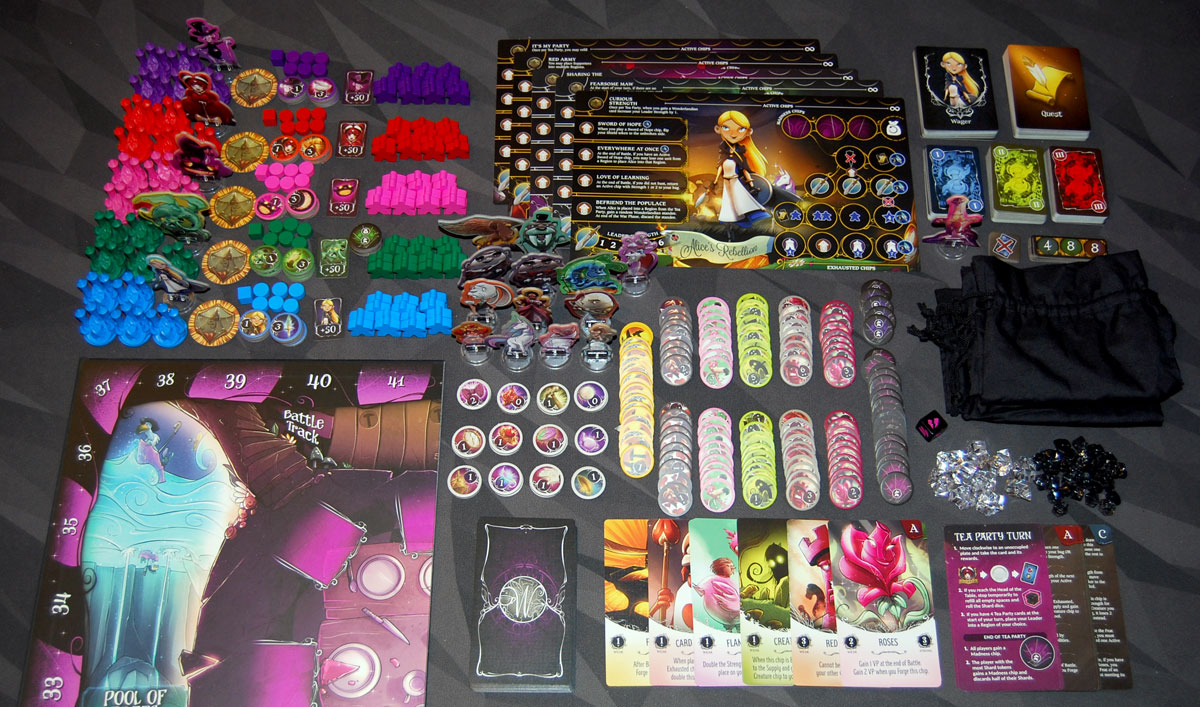
Wonderland’s War Components
Wonderland’s War has a lot packed into the box! I borrowed the retail edition from the designers (who are local to me) and here’s what’s in the box:
- 5 Sets of Faction Components, each including:
- Faction board
- Character standee
- Shield token
- Battle Track marker
- 6 Faction discs
- 4 Starting chips
- 6 Artifact chips
- 50+ Score token
- 14 Supporter meeples
- 5 Castles
- 4 Wager cards
- 30 Quest cards
- 90 Tea Party cards (30 each for 3 rounds)
- Starting Battle Standee
- 2 4p/5p tokens
- 6 Region Scoring tokens
- Game board
- 13 Wonderlandian Standees
- 24 Wonderlandian chips
- 24 Wonderlandian cards
- 25 Forge chips
- 95 Ally chips (19 each in 5 types)
- 21 Ally cards
- 5 Cloth bags
- Shard die
- 40 Madness shards (30 small, 10 large)
- 15 Player reference cards
- Player action aid (not pictured)
One thing you need to know about Druid City Games is that they love their components. I haven’t always been a fan of that, but to me it depends a bit on the game. For Grimm Forest, I did complain that it felt a bit like a small-box game that had gotten a lot bigger (and pricier) because of a lot of unneeded miniatures. On the other hand, Tidal Blades (from the same designers and publisher) felt like it justified the extra-large box because the game itself was an outsized adventure in a sprawling new world. Suffice to say, if you get a Druid City Games title, you can expect it to have an impressive table presence. In the case of Wonderland’s War, there are a lot of components, and the game takes up a sizable amount of space on the table, primarily due to the board itself, but also because of several tarot-sized cards and a large cast of supporting characters in the form of standees and tokens.

Let’s start with the main game board itself, which is a six-fold board—you’re gonna need a big table, because in addition to this board you’ll have up to five player boards as well, not to mention a lot of cards and tokens. The board has several different sections: a score track around the edge, a battle track across the top, a tea party (with spaces around the table for the small Euro-sized cards), and then five regions where battles will take place. Possibly the board could have been sized down slightly because the regions don’t necessarily get filled up, but the limiting factor for the tea party is having room for all of the cards. The artwork for the game is by Manny Trembley (whom you may recognize from Dice Throne), and he does a great job of creating a vibrant, off-kilter Wonderland. Hope you like pink and purple!
The chips—and there are a LOT of them—are cardboard punch-out tokens. The ally chips come in two denominations for each ally, and there are also a lot of Wonderlandian chips, as well as chips for each character and madness chips. The premium chips—available either as a $50 add-on or included in the $180 pledge tier—are premium clay chips, comparable to those from Splendor but smaller. I got to play with those at a game demo, and I do have to admit that they’re very nice. Are they worth the extra $50? That’s up to you and how much you’ll be playing this game—I definitely enjoyed using them for the demo and they’re a lot easier to handle when mixing them up in the bag and drawing out chips, but it’s not cheap. The nice thing is that the premium chip upgrade comes with its own tray that fits inside the deluxe box.
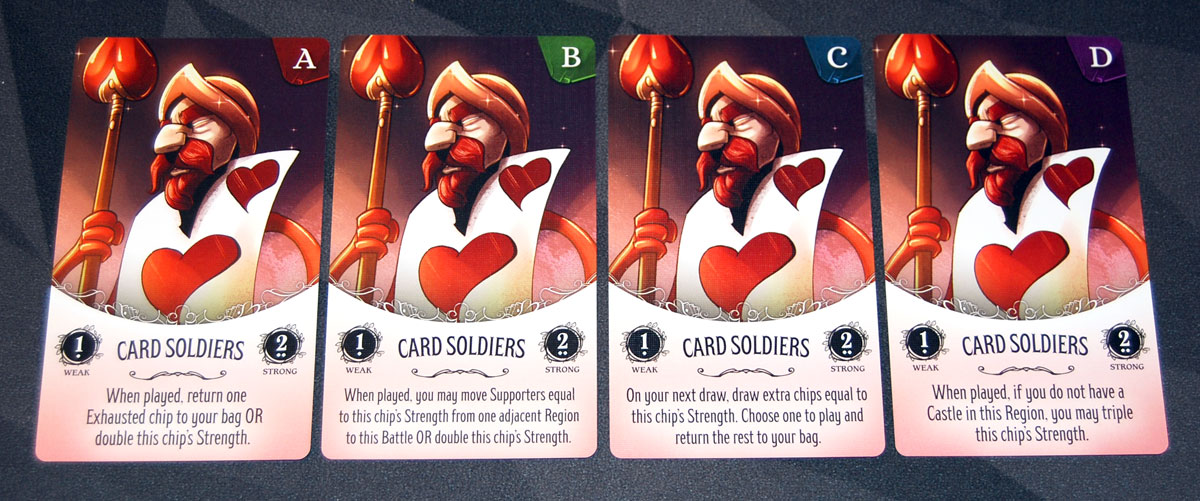
Wonderland’s War uses the ally chips similar to the way Quacks of Quedlinburg uses the ingredient chips—in every game, you use all five types of ally chips, but the set of cards you use will determine what each chip actually does. There are four versions of each ally, with a tarot-sized card to go along with each one. For instance, the Card Soldiers are the weakest chip on their own, but their powers can make them stronger or let you draw additional chips.
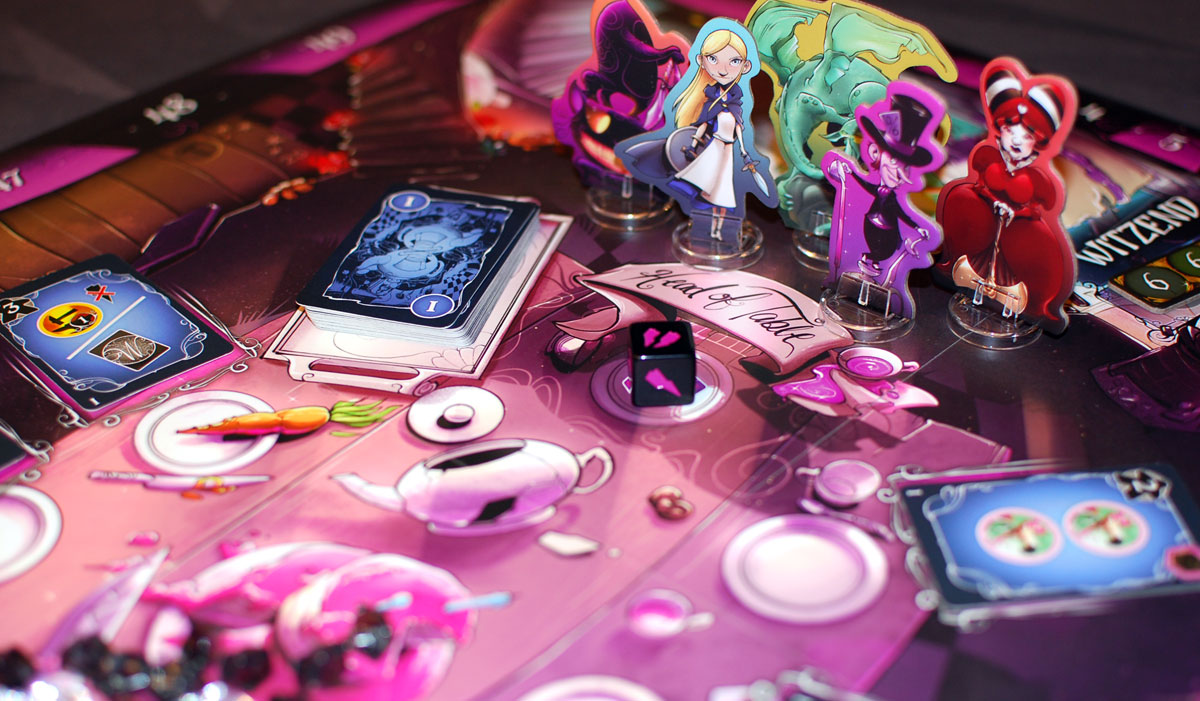
The retail edition of the game comes with cardboard standees with plastic bases. There are standees for each player, one that marks the starting battle, and then a baker’s dozen more for the Wonderlandians, some additional characters that you can recruit. I like the standees, as somebody who generally doesn’t paint miniatures, because they’re colorful and easy to tell apart, though the size of some of the standees (I’m looking at you, Jabberwock!) means they can be easy to knock over. The deluxe edition includes plastic miniatures for all of the characters, which look excellent but are all gray, including the player characters.
The deluxe edition has a few other differences from the retail, which I’ll list here:
- The supporter meeples in the retail edition are all the same shape, though larger than your typical meeple. THe deluxe edition has a custom shape for each different faction—the Red Queen has card soldiers, the Mad Hatter has a teapot, and so on.
- The retail edition has the black cloth bags seen in my photo. The deluxe edition has custom bags for each character, colored to match the pieces and with the character image on the bag. They also have the flat bottom. These are quite nice, and definitely make it easier for mixing the chips and reaching your hand in.
- The castles in the retail edition are all the same plastic miniature, just in different colors. The deluxe edition includes custom castles for each character and it also includes a set of the retail model so you have both. The starting battle token (which looks like a sword stuck in the ground) also gets a plastic miniature.
- The retail edition has two layers of cardboard inserts. The deluxe edition has a taller box to accommodate all the extras, and GameTrayz to keep everything organized.
With the pledge tier options, you have some flexibility: if you own the game already, you can pledge for just the mini-expansion, just the premium chips, or pick one and add on the other. You can get just the deluxe edition (and add expansion and/or chips), or get the whole kit and kaboodle.
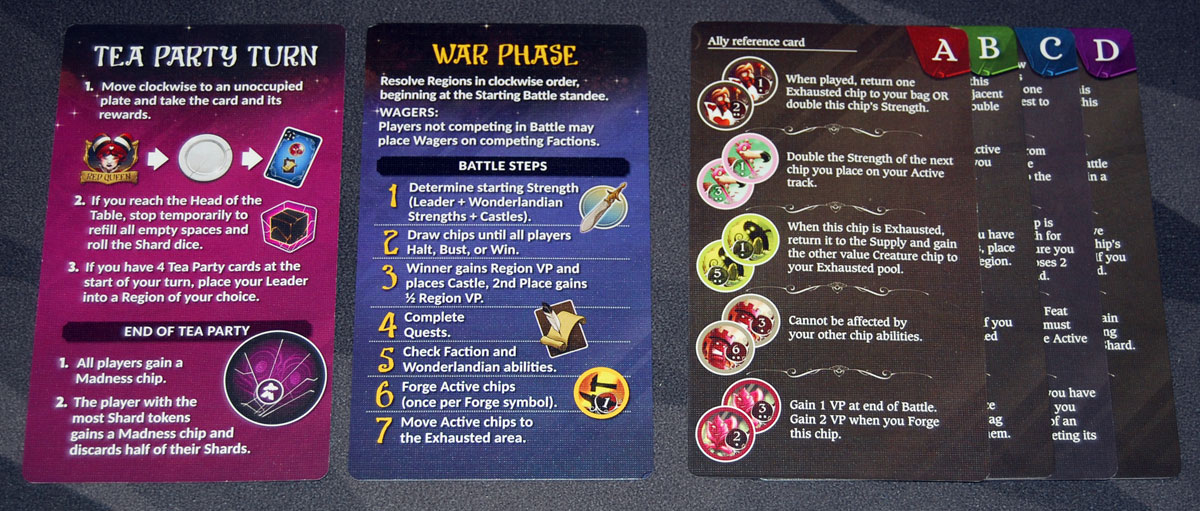
There are three different player aid cards, double-sided, that help you keep track of things. The first one has reminders for the two phases of the game, the tea party and the war. The other two reference cards are for the ally chips: in each game, you’ll use a set of ally cards labeled A, B, C, or D, and these reference cards tell you each chip’s ability. These are tarot-sized cards because of the amount of info on them.
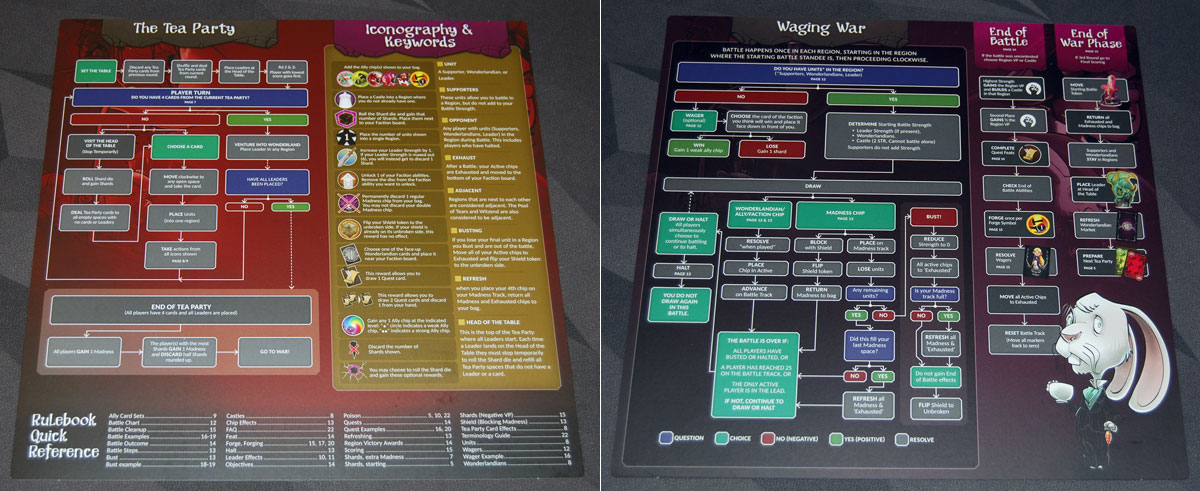
But wait, there’s more! There’s one large reference sheet included that has flowcharts for the two phases of the game, plus a list of iconography and keywords. This is in addition to the rulebook, and it’s quite handy: while you still need somebody to have read the rulebook, this helps you step through the various actions in a way that you don’t have to flip back and forth in the book, but there’s also an index for page numbers in case you need to look up a concept in more detail.
How to Play Wonderland’s War
You can download a copy of the rulebook here.
The Goal
The goal of the game is to score the most points over 3 rounds by winning battles, building castles, and completing quests.
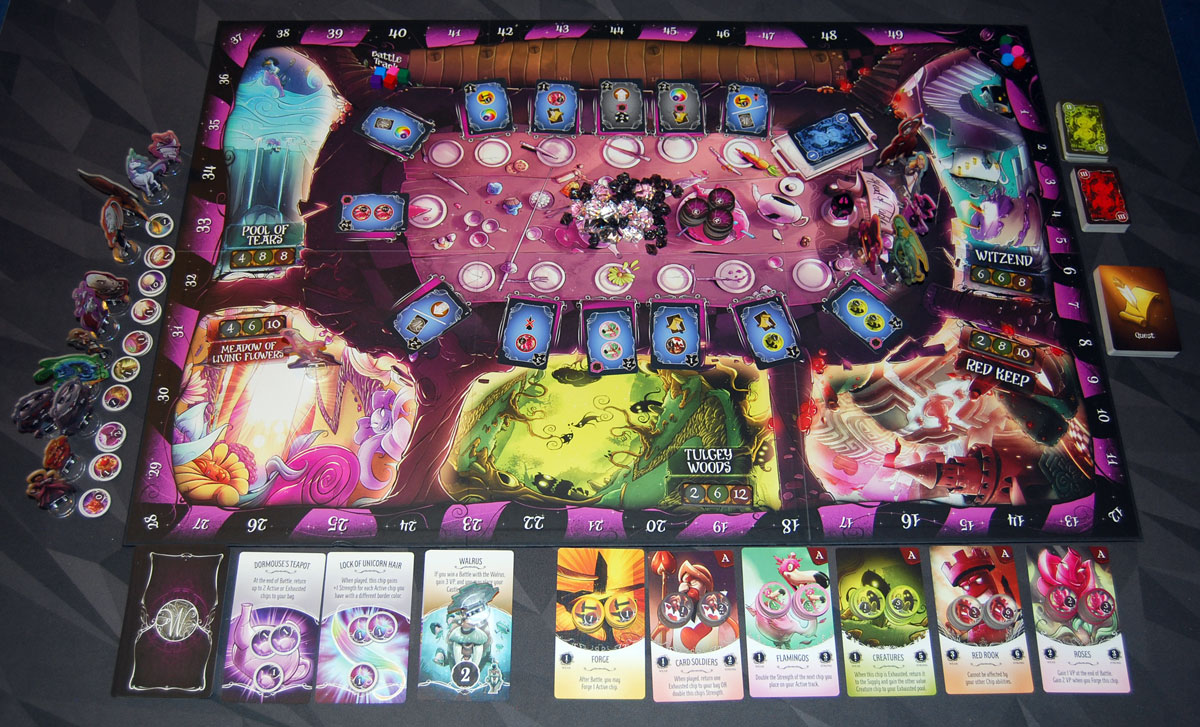
Setup
On the main board, you shuffle the region scoring markers and place one in each region. The starting battle marker is placed a number of spaces clockwise from the Red Keep based on a roll of the die. The tea party cards for the first round are shuffled and dealt out face-up in the spaces around the table. (With fewer than 5 players, some of the spaces are unused and are covered.) The shard die, shards, and madness chips are placed on the tea party table.
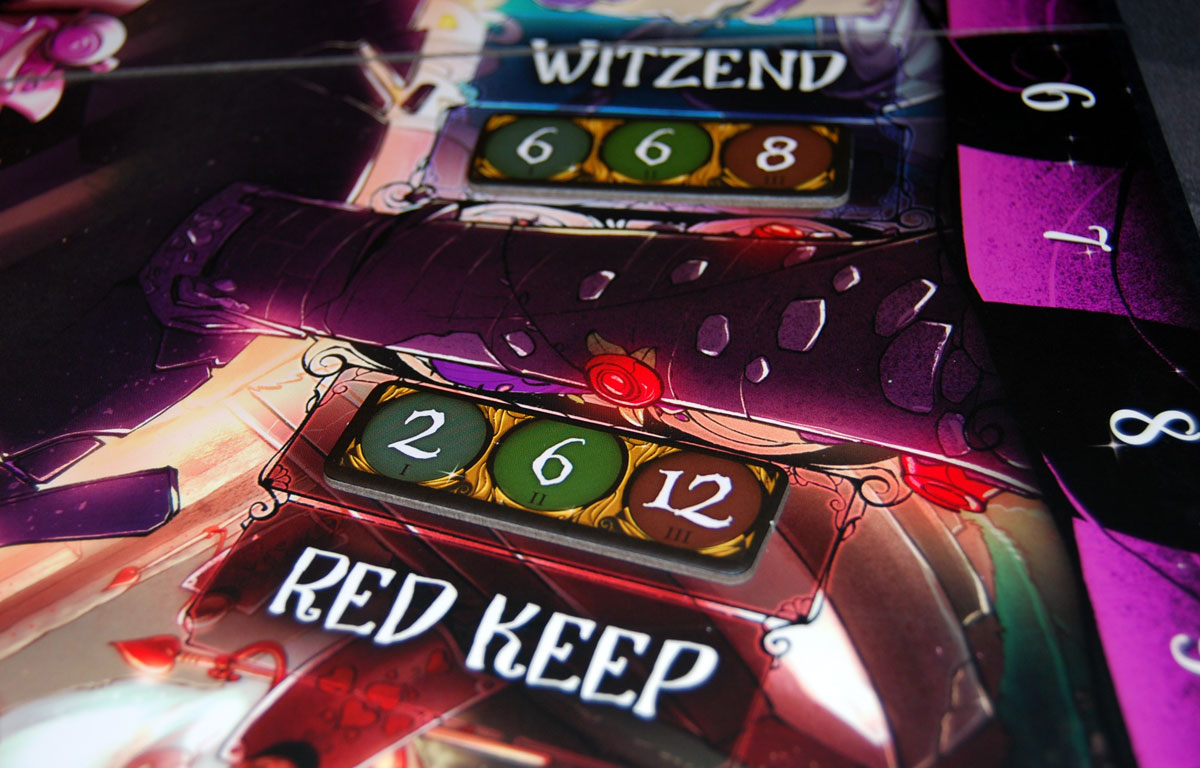
Shuffle and reveal three Wonderlandian cards, and set out the forge and ally cards along with all of the corresponding chips. Set the Wonderlandian standees and tokens off to the side, as well as the tea party cards for rounds 2 and 3 and the quest cards. Each player places a disc on the start of the scoring track, and the cube at the start of the battle track.
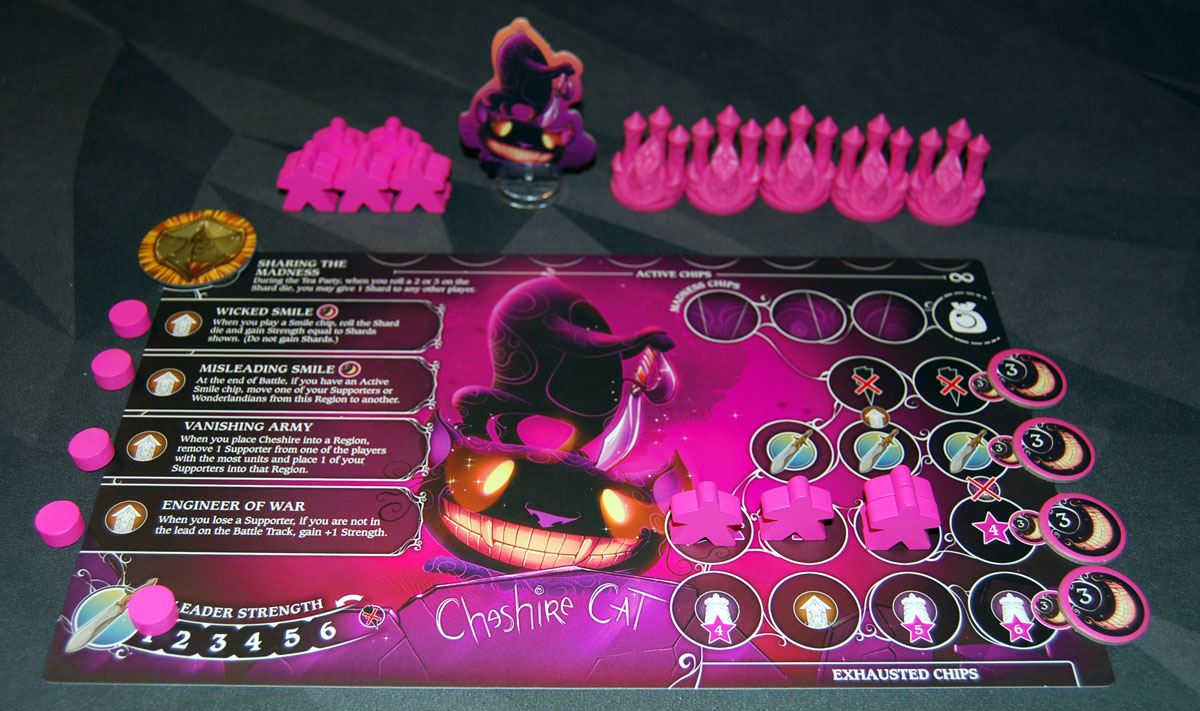
Each player chooses a character and takes all of the corresponding components. On your board, you place a disc on each of the four upgrades, as well as on the first space of your leader strength track. Place four meeples on the chip spaces as indicated, and place four of your artifact (value 3) chips on the right side of the board, near the small icons that match it. Place your shield token, active side up, at the top corner of your board. You should have 10 meeples and five castles in your supply, as well as your leader standee. Place your leader standee at the head of the tea party table.

In your bag, you should place your value 1 and 2 chips, two artifact chips, 1 forge chip, 2 madness chips, and one double madness chip.
Players will also start with some shards, based on player count and player order.
Gameplay
The game takes place over 3 rounds, and each round has a Tea Party Phase and a War Phase.
Tea Party Phase
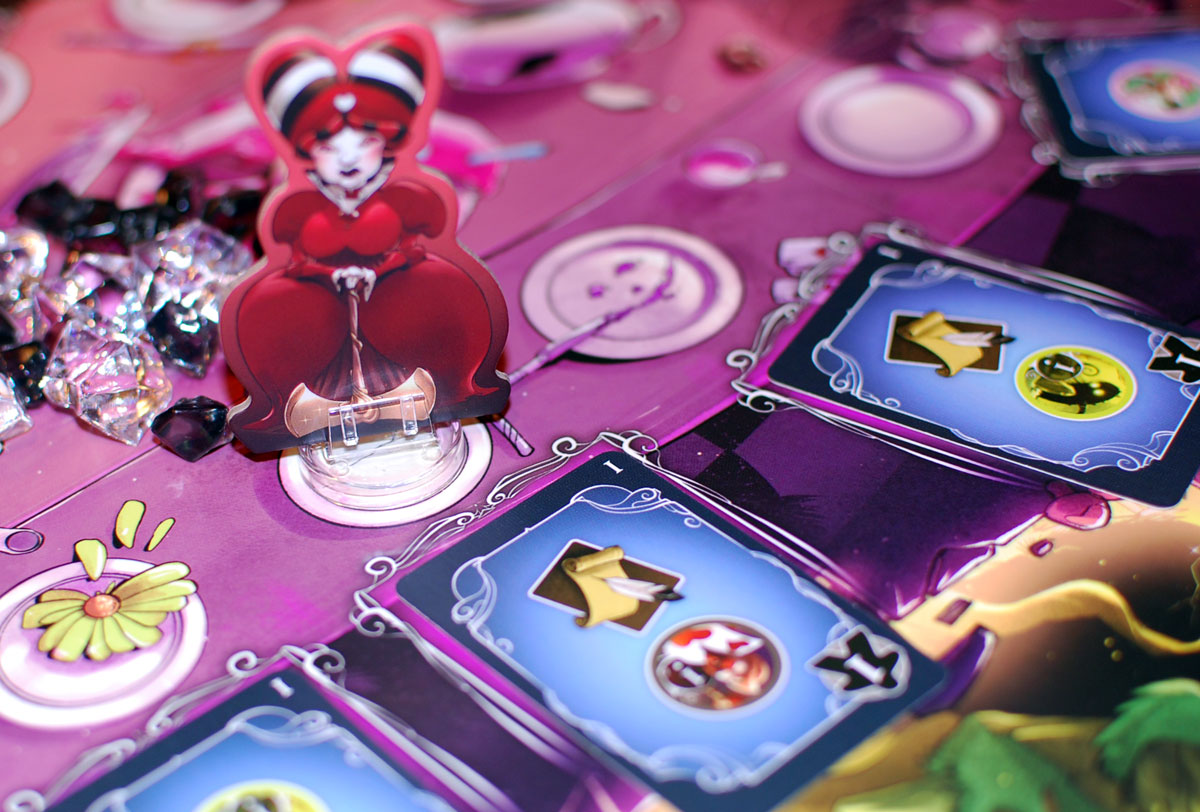
During the Tea Party Phase, players take turns moving their leaders clockwise around the table to collect tea party cards. You may move any number of spaces to an unoccupied space with a card, and then you take the card that is present there. If you reach the head of the table, you must pause: roll the shard die and collect that many shards, refill cards on all unoccupied spaces, and then continue moving to a space with a card.
Each of the characters has a special ability that may only be used during the tea party.
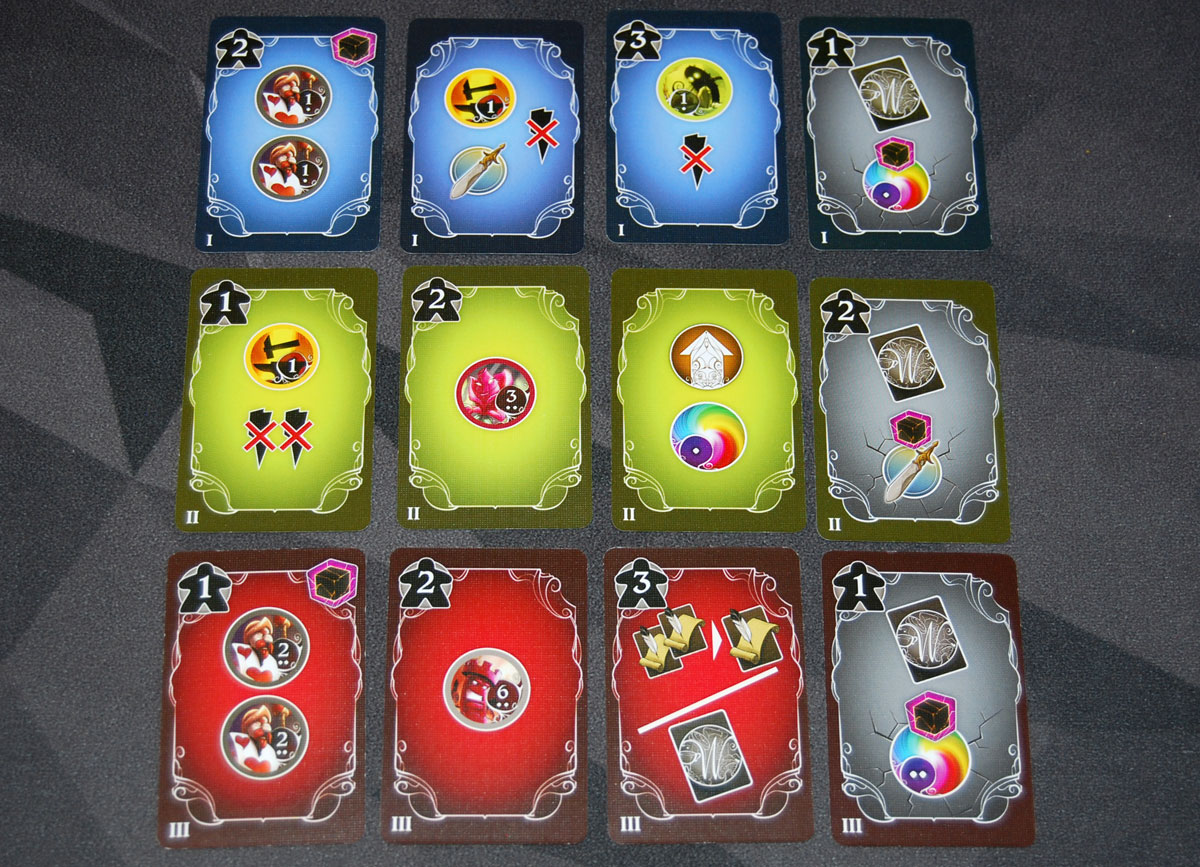
Tea party cards have various effects. A meeple in the top corner lets you place that many supporters in a single region. A black cube in the top corner means you must roll the shard die and collect shards to take that card. Other effects will let you gain chips to put into your bag, discard shards, increase your leader strength, choose a player upgrade on your board, and recruit Wonderlandians.
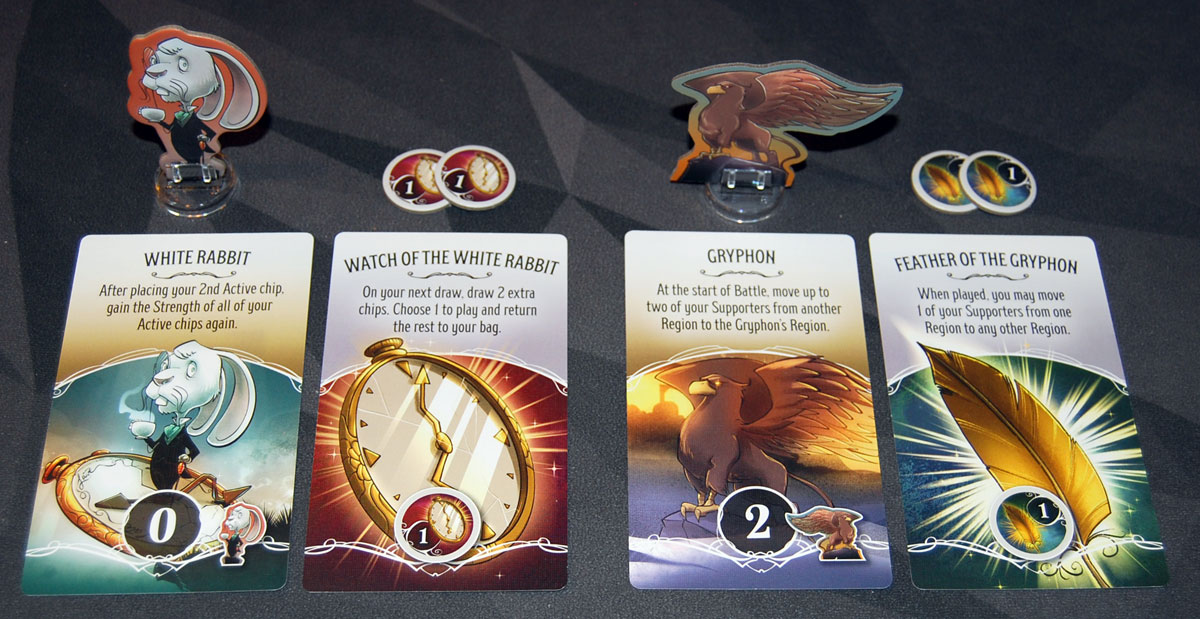
When you recruit a Wonderlandian, you choose one of the face-up cards and take it, along with the corresponding standee (which is placed in a region of your choice) or chips (which go into your bag). The characters count as your supporters and they have their own strength value and special effects during battle. The tools give you two chips that have abilities when pulled from your bag during a battle.
If you have 4 tea party cards from the round, at the start of your turn instead of moving around the table, place your leader into any region. Once all players have placed their leaders into regions, the tea party ends. Everyone gains a madness chip; the player with the most shards gains an additional madness chip and then discards half of their shards.

War Phase
During the War Phase, you will resolve each of the five regions, starting with the region that has the starting battle standee.
If you’re the only player with any units (not counting castles) in a region, you win the battle automatically, but you only get one reward: either the points indicated for that region or to build a castle there. (You may only have one of your castles in each region.)

If there are at least two players with units, there will be a battle. First, any players who are not present may place a wager if they want: choose the player you think will win the battle, and place the corresponding wager card face-down in front of you.
The players involved in the battle first calculate their starting strength, based on their leader strength (if present) and any Wonderlandians they control at that region, and then marking that on the battle track. Castles are worth 2 battle strength.
Then, all players in the battle draw a chip from their bag.

If you draw a madness chip, it goes in the madness track on your player board, and you lose the number of supporters indicated on the chip. If your shield is active, you may flip it over to put the madness chip back into the bag and ignore it. If you fill your madness track, you take all of the chips from your “exhausted” area and the madness chips and place them back into your bag. If you have no more units in the region, you bust and drop out of the battle, moving all of your active chips to exhausted and setting your battle strength to 0.

Otherwise, you place the chip in your active chips section, and increase your value on the battle track. Many chips have special effects as well, so be sure to take those into account.
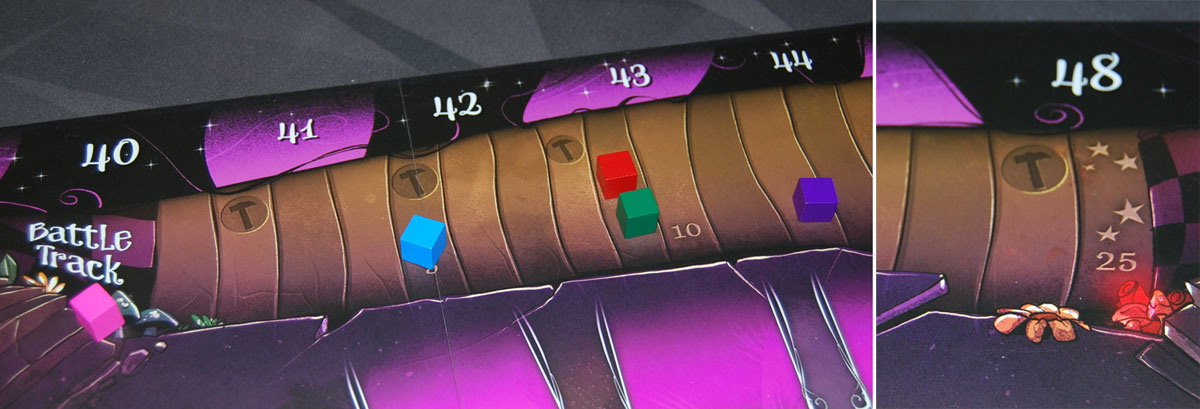
If there are still at least 2 players who haven’t busted, the battle continues and they each draw another chip, and so on. If you choose to halt, you reach into your bag but pull out an empty hand, at which point you will no longer draw chips from the bag.
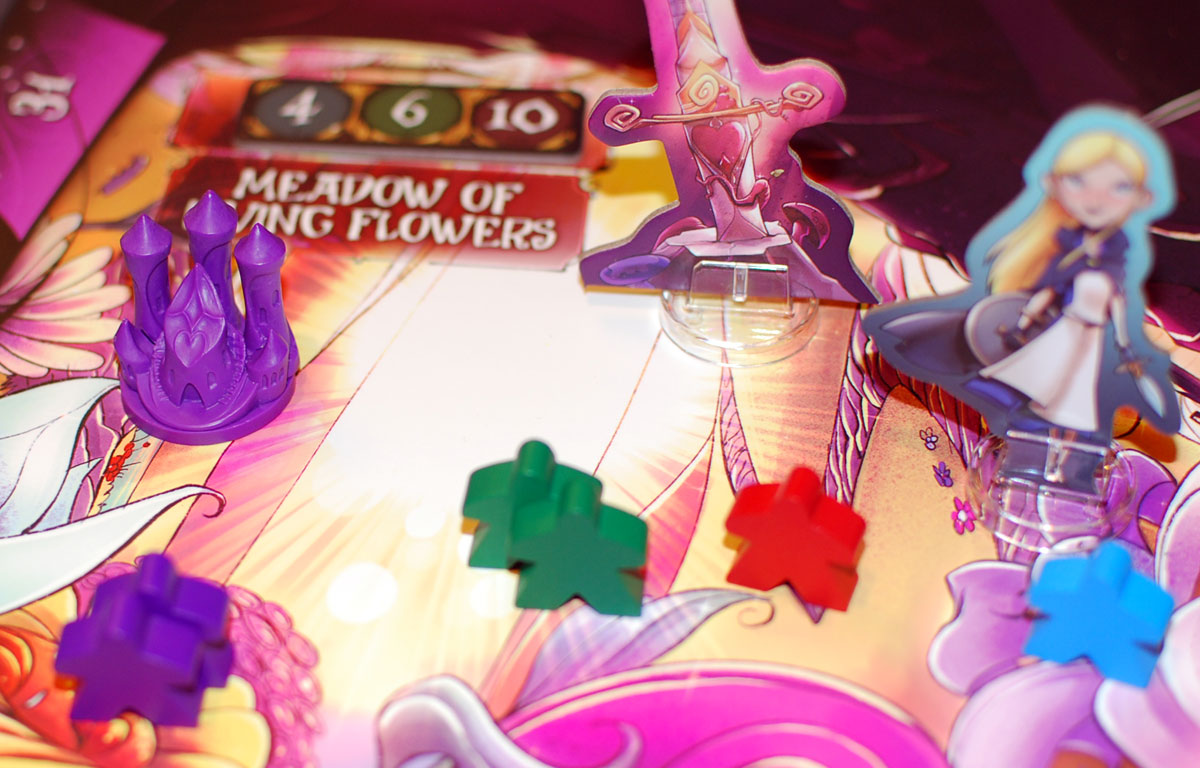
Once everyone has halted or busted, the player who is highest on the battle track wins: they get the points for the region and may place a castle (if they don’t have one already). The player with the second-highest battle strength gets to choose either the points or the castle.
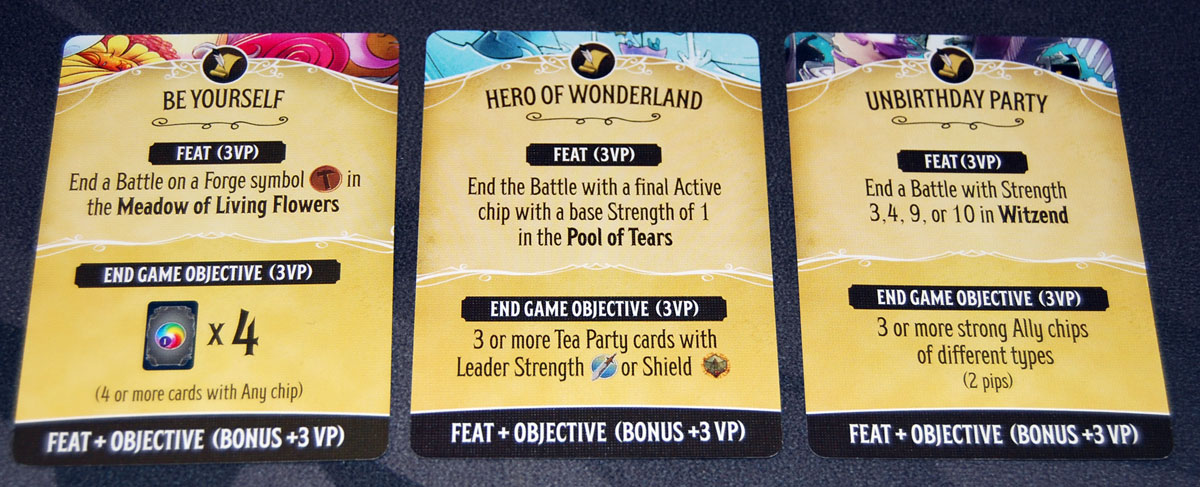
If you accomplished a feat from a quest card during a battle, you may reveal the card and place it face-up. Feats challenge you to meet particular conditions, usually at a specific region: you might need to end with a particular battle strength, or end on a forge space.
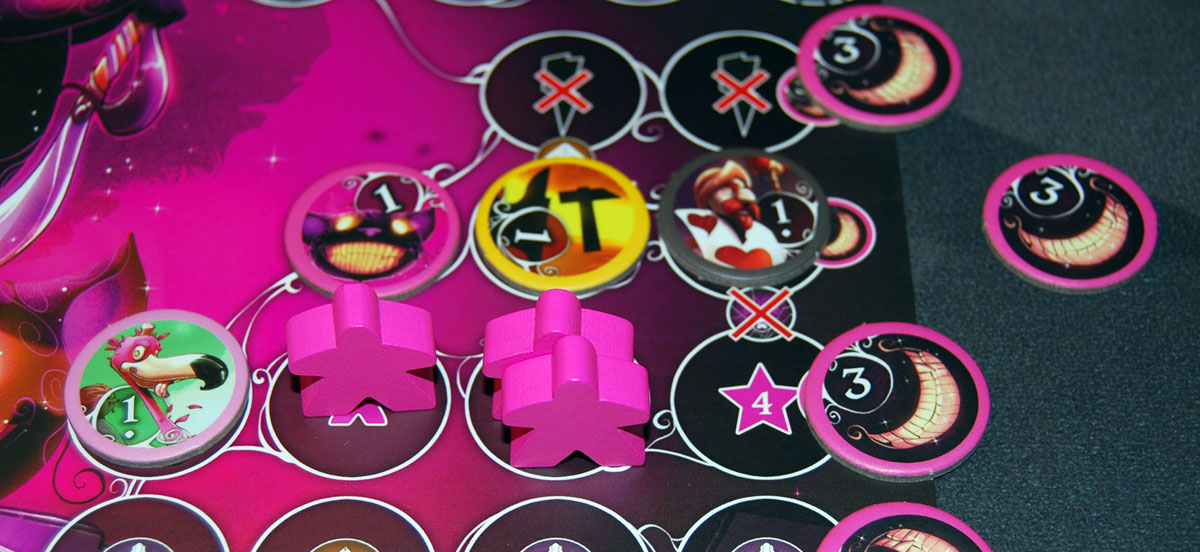
For each forge chip in your active chips, you may forge one of your active chips (including the forge itself) by moving it to one of the tracks on your player board, which are filled from left to right. You may also forge a chip if you ended on a forge space on the battle track. The player board tracks have various effects: you will remove shards, increase your leader strength, gain supporters, increase the value of your castles, and gain upgrades. If you reach the end of a track, you immediately gain the 3-value artifact chip there and place it into your bag.
Then any wagers are resolved: players who wagered reveal their cards. If you were correct, you gain any weak ally chip. If you were wrong, you take a shard. (In the case of a tie for a battle, nothing happens for the wager.)
All players move their active chips to their exhausted area, and then you move to the next battle.
After all five regions have been resolved, the round ends. The starting battle standee is moved based on the shard die, all chips are returned to players’ bags, and any supporters and Wonderlandians that were not lost remain in the regions where they were placed. Leaders are returned to the head of the table, and the Wonderlandians cards are reshuffled and 3 more revealed.
Repeat the same process for a total of three rounds.
Game End
The game ends after three rounds. Players add points for each of their castles on the board, worth between 3 and 6 points depending on the bottom row of their forge tracks.
For each feat that you completed, you score 3 points. Quest cards also have end game objectives: if you meet one of these (whether you completed the feat or not), you score 3 points. If you completed the feat and the objective on the card, you score an additional 3 points.
Lose 1 point for each shard.
The highest score wins and becomes the new ruler of Wonderland. Ties go to the player with the fewest shards, and then the most units on the board.
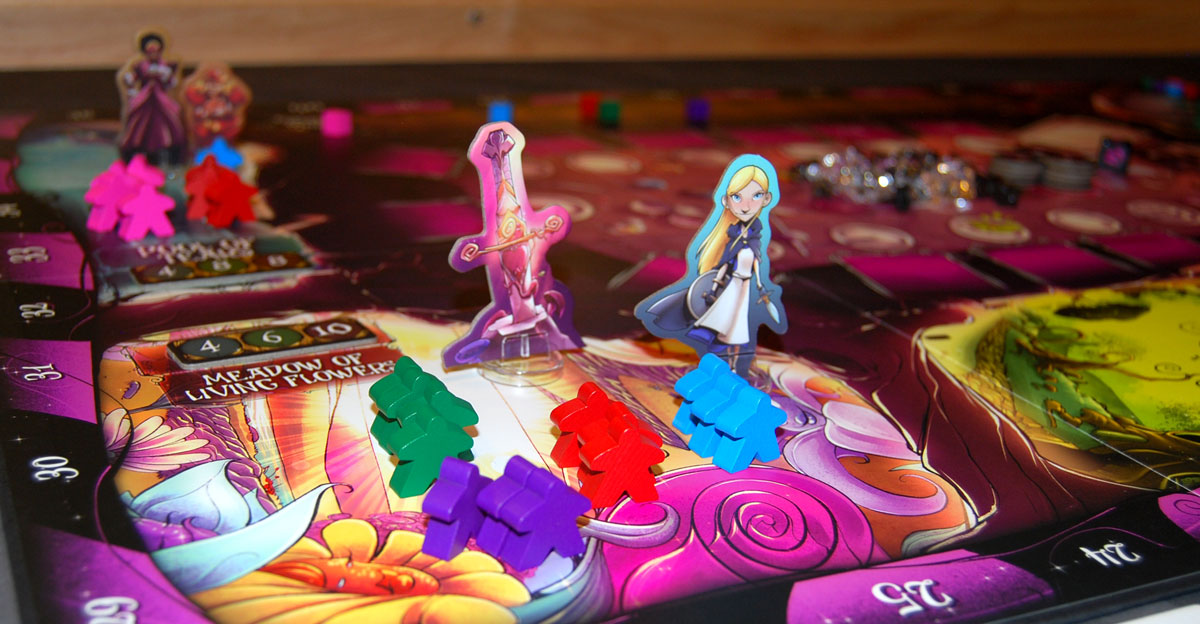
Why You Should Play Wonderland’s War
Wonderland’s War combines the bag-building press-your-luck of Quacks of Quedlinburg with a tight battle for area control, and wraps it all in an eye-popping Alice in Wonderland package. It’s a game for players who like to strategize and plan for battle, explore a tech tree and find synergies in special abilities, but also don’t mind the way that wild swings of luck can throw all of that planning out the window.
Each player starts with the same small pool of chips—mostly low valued, and for the most part without any special effects, so a battle would be evenly matched and would entirely depend on your luck drawing your high-valued artifact chips rather than your madness chips. However, it doesn’t take long before things start to diverge.
First, you’ll be picking up tea party cards, many of which will add chips to your bag of tricks. In early rounds, you’re generally granted the “weak” chips with lower values, and in later rounds you’ll have access to the “strong” chips instead. The particular effects will depend on the specific set of ally cards used, but they have wild and varying abilities. Some examples: the Flamingo (A) will double the strength of the next chip placed on the track, so it’ll help no matter what but can make a big difference if you draw a strong chip. Creatures tend to have weird abilities that bounce back and forth between the weak and strong versions. The Red Rook is one of the higher value chip, but its effects tend to be penalties.
Not all of the tea party cards are allies, though. You can also pick up Wonderlandians, which are fun because they’re entirely unique—you’ll be the only one with that ability. You’ll also want to be sure to grab some quest cards because they’ll help you choose which regions to send supporters to and give you some end game objectives to work toward. And, of course, tea party cards are generally how you’ll actually get your troops onto the board in the first place.
In Wonderland’s War, unlike many area control games, your troops don’t actually provide any strength—that comes from your leaders and the Wonderlandian characters. What the supporters do is protect you from busting while you draw chips from your bag. Each time you draw madness chips, you’ll lose supporters—lose all of them and you’re out of the fight. Having more supporters doesn’t guarantee you’ll win, but it certainly gives you more chances to stay in the battle.
Now, a note about the madness: certainly the concept of madness and the way it’s used in this game stems from the source material, where the madness was often portrayed as a sort of twisted logic that Alice couldn’t follow. Wonderland was filled with nonsense, and Alice’s rational arguments and normal understanding of the world generally didn’t apply. I’ve seen theories that various characters represent different types of mental illness, and that Lewis Carroll used the stories to challenge assumptions about them, but I’m not sure how much of that is true. In the game, the madness shards and chips are often gained as a result of taking more powerful actions but are negative in themselves. Is that an accurate adaptation of Carroll’s message? Perhaps not, so some players may be uncomfortable with this theme and mechanic, even with its literary origins. The new expansion delves into it even more: it’s titled The Shards of Madness, and introduces new Wonderlandians with a lot of effects that move shards around and change the way the madness chips are distributed.
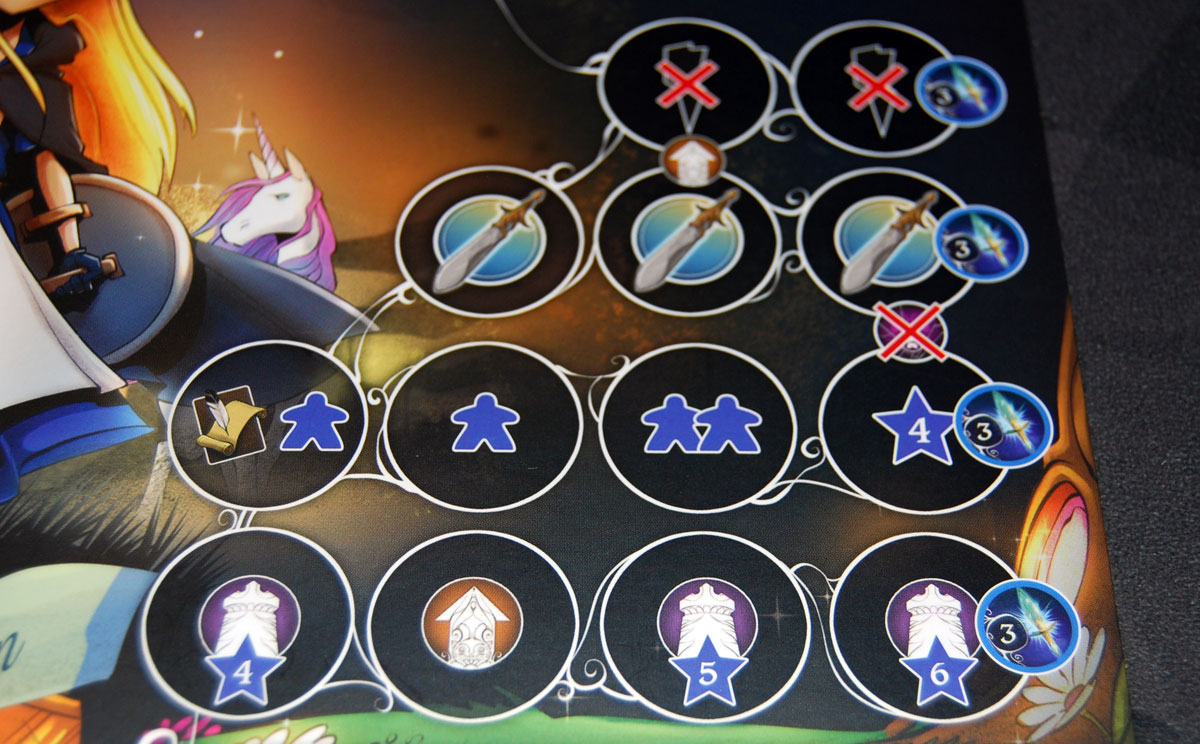
The forge tracks are the tech tree of Wonderland’s War, and everyone has the same tracks to work with. Forging is a nice mechanic: not only does it move you up on the tech tree, but it’s also how you weed chips out of your bag (though you can’t weed madness chips this way). The forge is only a value 1 chip, but you can use it to forge itself or another weak chip. The tracks help you get rid of shards (those are negative points and increase the risk of more madness chips), raise your leader strength, get more supporters, increase the value of your castles, and get your faction upgrade abilities. It’s also how you gain access to your 3-value artifact chips.
You do need to be careful about the balance of of chips in your bag and how many you forge, though, particularly if you’re planning to engage in multiple battles. You only refill your bag each time your madness track is filled, and then it’s your exhausted chips and madness chips that go back into the bag. Anything in your active row stays there (unless you busted). Sometimes you have to halt earlier than you’d like in a battle simply because there’s a later battle that you know you’ll need more chips to win.

Speaking of the artifact chips, not only are they the highest value chips that you start with, but each faction also has two upgrade abilities that affect their artifact chips, along with two additional passive abilities. For instance, Alice (pictured above) can reactivate her shield when she plays an artifact, or move Alice herself into a region at the end of battle, potentially swinging the balance in her favor. Of course, you have to work toward getting these upgrades, but there are some very fun combos for each character.
The regions are mixed in point value based on the randomly placed scoring tiles, and they vary from round to round. The Red Keep may be one of the least valuable in the first round, but worth the most in the last round. Is it worth trying to battle there early on? Well, if you win because nobody else bothered for the 2 points, you could get a castle in place to boost your strength for later.
The quest cards also have some wacky effects on the battles. You can’t always tell who’s present because they’re really hoping to win a region, and who’s there just because they’re trying to end a battle with a value 1 chip in their active row in that particular region. Quite often, one player will invest a lot in a battle, only to discover that another player bailed out after only one or two draws, content to score for a feat instead.
I’ve only gotten to play Wonderland’s War a few times so far, but I’ve really enjoyed the mix of bag-building and area control. I like the fact that there are more effects for the allies to mix up the game, but even with the A-side of the ally cards I feel like there’s a lot to explore already. I definitely enjoyed playing the game with the premium chips and custom bags during the demo, even if I felt the box was a bit overwhelming in size with all those trays. The tactile feel of the chips was great! But even the retail edition is an impressive game and the gameplay is solid either way.
If you’re interested in the retail edition, visit the Skybound website here. For more information or to make a pledge for the deluxe edition, visit the Wonderland’s War Kickstarter page!
Click here to see all our tabletop game reviews.
![]() To subscribe to GeekDad’s tabletop gaming coverage, please copy this link and add it to your RSS reader.
To subscribe to GeekDad’s tabletop gaming coverage, please copy this link and add it to your RSS reader.
Disclosure: GeekDad was loaned a copy of this game for review purposes.




